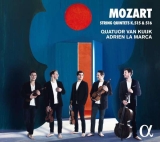 Wolfgang Amadeus Mozart: Streichquintette C-Dur, KV 515, g-Moll, KV 516; Adrien la Marca, Bratsche Quatuor Van Kuijk (Nicolas Van Kuijk, Sylvian Favre-Bulle, Violinen, Emmanuel François, Bratsche, François Robin, Cello); 1 CD Alpha Classics 587; Aufnahme 03/2019, Veröffentlichung 10/2020 (67'06) - Rezension von Uwe Krusch
Wolfgang Amadeus Mozart: Streichquintette C-Dur, KV 515, g-Moll, KV 516; Adrien la Marca, Bratsche Quatuor Van Kuijk (Nicolas Van Kuijk, Sylvian Favre-Bulle, Violinen, Emmanuel François, Bratsche, François Robin, Cello); 1 CD Alpha Classics 587; Aufnahme 03/2019, Veröffentlichung 10/2020 (67'06) - Rezension von Uwe Krusch

Der Autor des begleitenden Textes dieser CD stellt einige, sicherlich nicht nachprüfbare Überlegungen zu den Quintetten in C-Dur und g-Moll an, die aber durchaus plausibel sein können. Die ungewöhnliche Besetzung mit einer zweiten Bratsche zum Quartett, anders als etwa Boccherini zuvor mit zwei Celli, mag dem Umstand geschuldet schein, dass dieses das Lieblingsstreichinstrument des Komponisten war. Und ob man im Pochen des ersten Satzes und der Tonart g-Moll das fieberhafte Warten auf einen Antwortbrief des Vaters respektive die damit verbundenen unguten Gefühle hört, mag auch passen. Sei es drum, beide Werke stellen zusammen mit dem Don Giovanni die wesentlichen Kreationen im Jahr 1787 dar.
Nach der mehr als erfreulichen Aufnahme eines Divertimentos und von zwei Quartetten (Rezension) empfindet der Autor dieser Zeilen diese Aufnahme gewissermaßen als Rückschritt. Das gilt vor allem für das C-Dur Werk, das mit harten Akzenten, fast schon Schlägen überambitioniert wirkt. Für markante Betonungen lassen sich durchaus Argumente finden, aber trotzdem muss noch das Maß im Kontext gewahrt bleiben. Und das scheint hier überzogen. Beim Quintett KV 516 gibt im Schlusssatz ansatzweise wieder einen Rückfall in diese harsche Herangehensweise. Die beiden Mittelsätze davor dagegen zeigen wieder die Besinnung auf die natürlich sich entwickelnde Struktur der Komposition und gefallen uneingeschränkt.
Das Quatuor Van Kuijk hat den Bratschisten Adrien La Marca hinzugezogen. Ihr Zusammenspiel lässt nicht den Eindruck aufkommen, dass diese fünf nicht immer zusammen spielen. Das ohnehin hochklassige Spiel des Quartetts wird durch diesen ebenso engagierten wie sensiblen Musiker gestärkt.
The author of the accompanying text of this CD makes some, certainly not verifiable, considerations about the Quintets in C major and G minor, which may be plausible. The unusual instrumentation with a second viola to form the quintet, unlike Boccherini’s previous quintets with two cellos, may be due to the fact that the alto was Mozart’s favourite string instrument. And whether one hears the throbbing of the first movement and the key of G minor as a feverish wait for a reply letter from the father, or the unpleasant feelings associated with it, may also be appropriate. Be that as it may, both works, together with Don Giovanni, represent the essential creations of 1787.
After the more than pleasing recording of a Divertimentos and two quartets (Review), the author of these lines feels this recording to some extent as a step backwards. This is especially true of the C major work, which, with its harsh accents, seems almost overambitious. Arguments for striking accents can certainly be found, but nevertheless their use should be measured. And they seem excessive here. In the final movement of the Quintet KV 516 there is a return to this harsh playing. The two middle movements, on the other hand, are quite natural and please without reservation.
The Quatuor Van Kuijk has enlisted the violist Adrien La Marca, who has also convinced as a soloist. Their playing does not give the impression that these five do not always play together. The already top-class playing of the quartet is definitely strengthened by this equally committed and sensitive musician.






















